Account Abstraction (EIP-4337): A Deep Dive into Ethereum's Evolution.
 Mrinmoy Porel
Mrinmoy Porel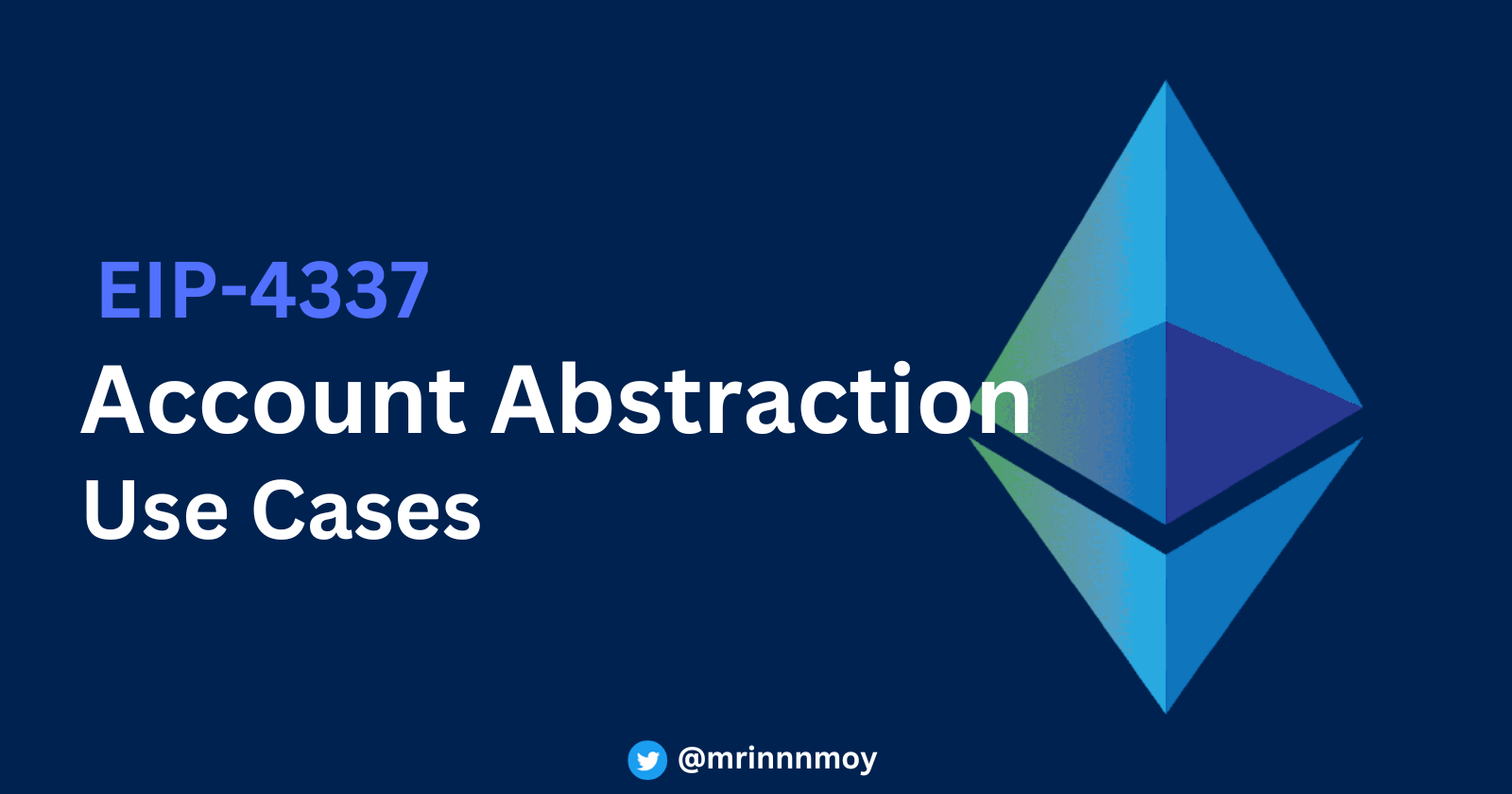
A Comprehensive Exploration of Account Abstraction (EIP-4337) - Understanding, Implementing, and Shaping the Future of Ethereum Smart Contracts.
Introduction
In the dynamic realm of blockchain technology, Ethereum has emerged as a trailblazer, fundamentally reshaping the landscape through its innovative concept of smart contracts. Introduced by Vitalik Buterin in 2015, Ethereum enabled the creation of decentralized applications (DApps) by allowing developers to encode self-executing contracts (Smart Contracts) directly onto its blockchain. These smart contracts automate a myriad of functions, from financial transactions to complex decentralized governance systems, fostering a new era of trustless and transparent interactions.
While Ethereum's smart contract capabilities revolutionized the blockchain space, the platform encountered challenges related to scalability and flexibility. As the ecosystem expanded, the need for improvements became evident, paving the way for a series of Ethereum Improvement Proposals (EIPs). At the forefront of these proposals is Account Abstraction, encapsulated in EIP-4337.
Account Abstraction addresses a critical limitation in Ethereum's current model. Account Abstraction seeks to decouple fee payments from Ethereum's native cryptocurrency, and support alternative verification mechanisms beyond ECDSA ushering in a new era of adaptability and expanded functionality. This article embarks on a journey to unravel the intricacies of Ethereum's evolution, exploring the transformative role of Account Abstraction in meeting the platform's evolving needs and enhancing its overall functionality.
Understanding Account Abstraction.
Ethereum Accounts
To understand the problems that EIP-4337 is trying to solve, we need to recap some stuff first. While talking about Ethereum, it has two different types of "accounts":
Contract Accounts
Externally Owned Accounts (EOAs)
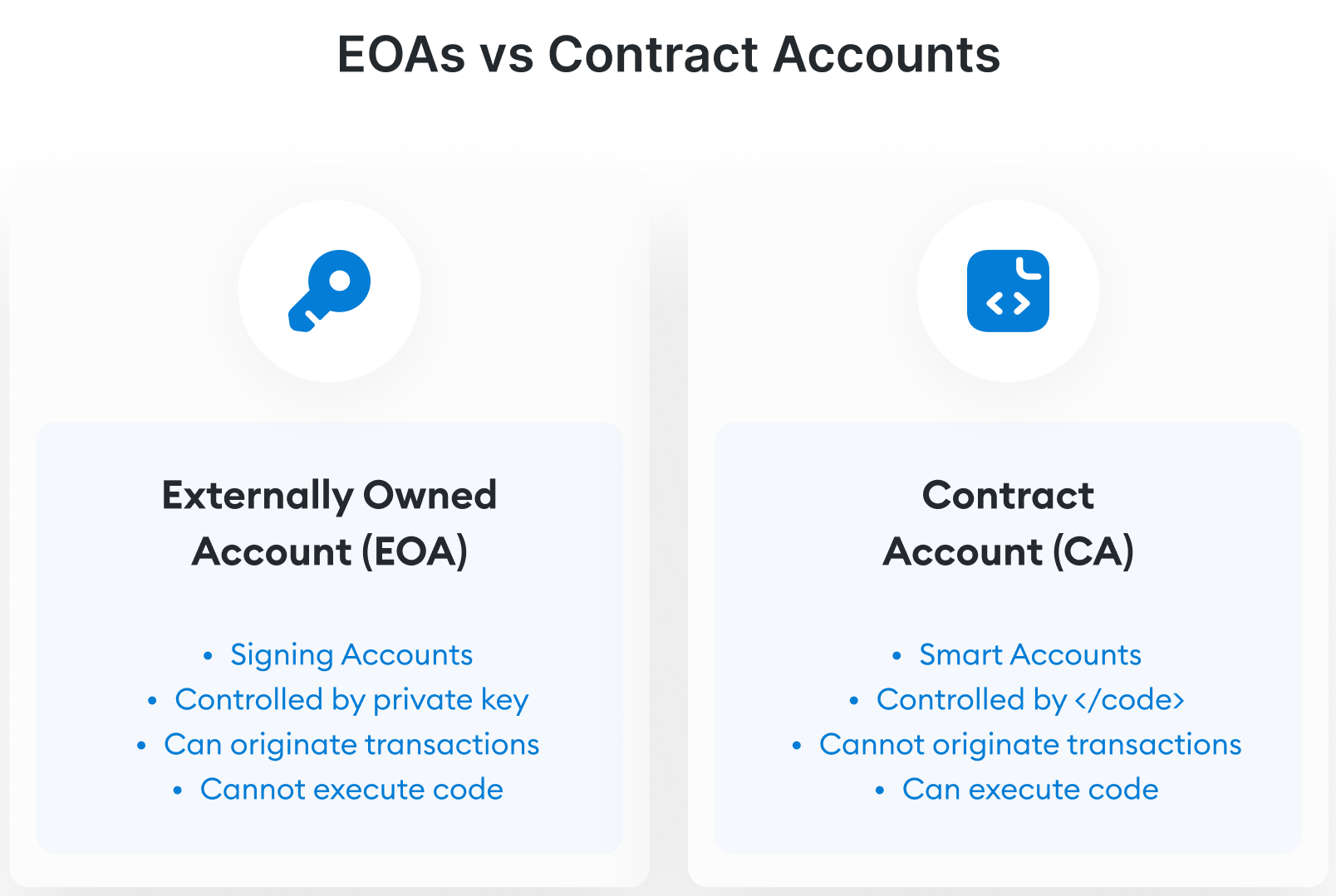
Externally Owned Accounts (EOAs): These accounts are like your personal wallets. They are created and managed by users using a pair of public and private keys. EOAs can initiate transactions and interact with smart contracts but have limited functionality and security challenges.
**Contract-**based Accounts: These are accounts created as smart contracts and controlled by code rather than private keys. They can perform complex logic but cannot initiate transactions or pay gas fees.
Limitations of EOAs

EOAs essentially come with limitations:
Security Concerns: EOAs rely heavily on a seed phrase, and losing it means losing access to your assets.
Gas Payment: EOAs must hold ETH for gas fees, limiting the use of other tokens.
Poor User Experience: Overall, EOAs offer a suboptimal user experience for newcomers as mentioned in the image above.
Not Quantum Proof: The current Discrete Logarithm problem on which ECDSA is based is by itself not quantum resistant.
Account Abstraction in the Context of Ethereum.
In the ever-evolving Ethereum ecosystem, Account Abstraction represents a pivotal paradigm shift in the way transactions are processed on the blockchain.
This paradigm treats all accounts, be they Externally Owned Accounts (EOAs) or Contract accounts, as smart contracts. By abstracting away the differences in account types at the protocol level, it simplifies the network's operation. This simplification extends to user interactions, enhancing wallet designs and reducing complexity, ultimately fostering a more user-friendly environment.
Fundamentally, Account Abstraction redefines the traditional transaction model by decoupling fee payment from smart contract execution. In contrast to the conventional method where users pay gas fees in Ether, and enables users to submit transactions without requiring native cryptocurrency. This flexibility not only streamlines the technical aspects of interacting with Ethereum but also offers a more accessible and user-friendly experience.
Historical Context: EIPs & Technological Progression.
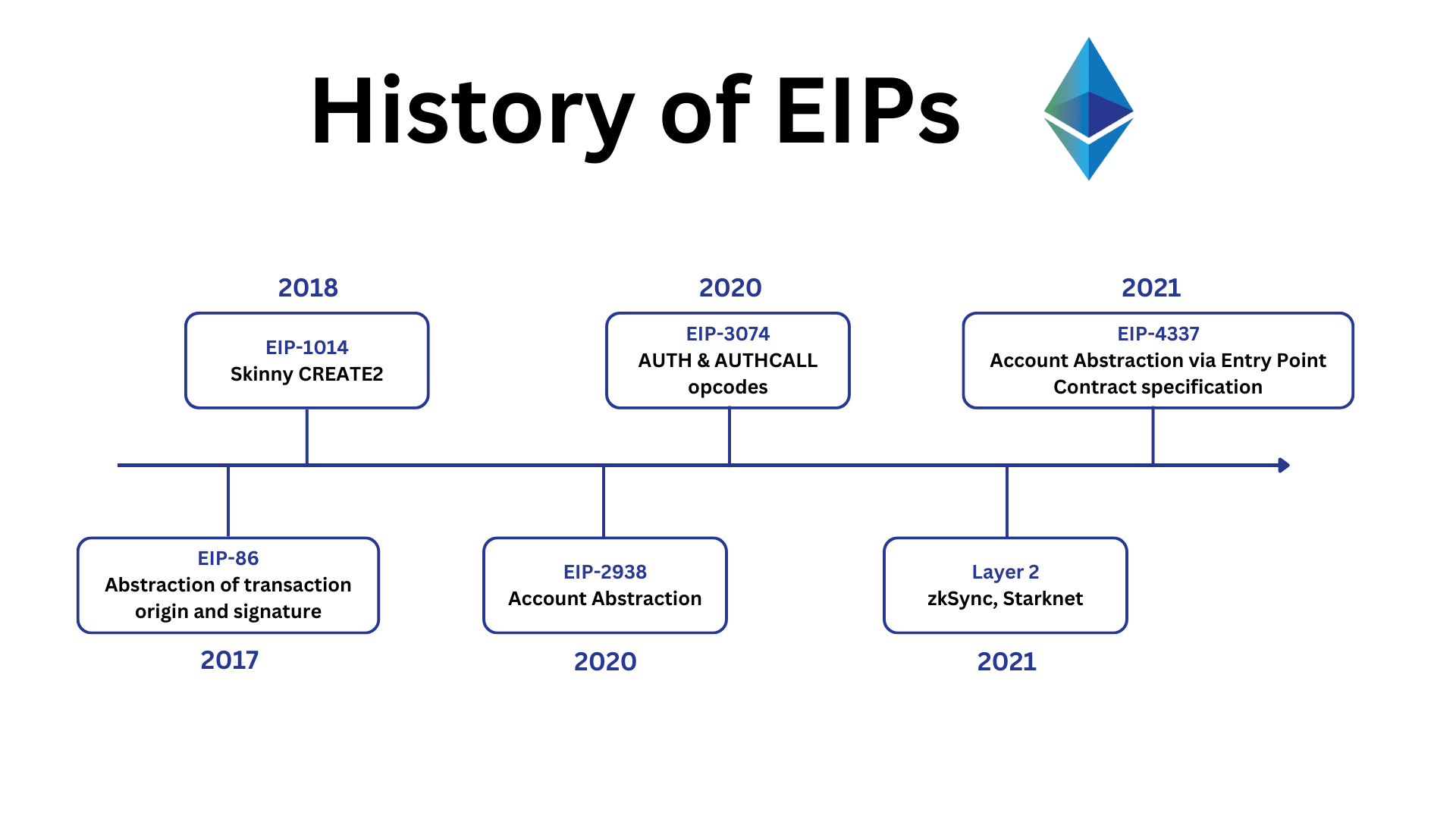
The evolution of Ethereum Improvement Proposals (EIPs) has been a dynamic journey, reflecting the continuous efforts to enhance the capabilities of the Ethereum blockchain. Several key EIPs have laid the groundwork for the development and implementation of Account Abstraction, culminating in the landmark EIP-4337. Let's take a closer look at the historical context and pivotal milestones that have shaped this transformative path.
Significant EIPs Leading to Account Abstraction.
EIP-86 (2016):
Pioneering Account Abstraction: EIP-86 is the first Ethereum Improvement Proposal focused on account abstraction, introducing a more flexible transaction processing paradigm.
Abstracting Signature Verification and Nonce Scheme: The proposal suggests changes to abstract signature verification and the nonce scheme, allowing users to create contract accounts with customizable transaction processing logic.
Flexibility in Contract Design: Implementation of EIP-86 empowers users to design contract accounts that aren't bound to traditional models, enabling the use of any signature or nonce scheme for transaction processing.
EIP-2938 (2020):
Restricted Account Abstraction: EIP-2938 introduces a limited form of account abstraction, permitting smart contracts to act as Externally Owned Accounts (EOAs), enabling them to initiate transactions and cover gas costs.
Introduction of New Transaction Type: The proposal advocates for a new transaction type, providing a mechanism for smart contracts to emulate EOAs and participate in transaction initiation on the Ethereum blockchain.
New Opcodes for Simplicity and Flexibility: EIP-2938 proposes the inclusion of two new Opcodes to facilitate the implementation of this restricted account abstraction. This approach prioritizes simplicity initially while allowing for the incorporation of more sophisticated features in the future.
None of these proposals have been merged into the Ethereum blockchain as they require consensus layer changes.
Until 2021, when EIP-4337 was proposed, account abstraction on Ethereum without a consensus layer changes required.
The Tech Behind Account Abstraction.
Explaining ERC-4337 using Transaction Flow.
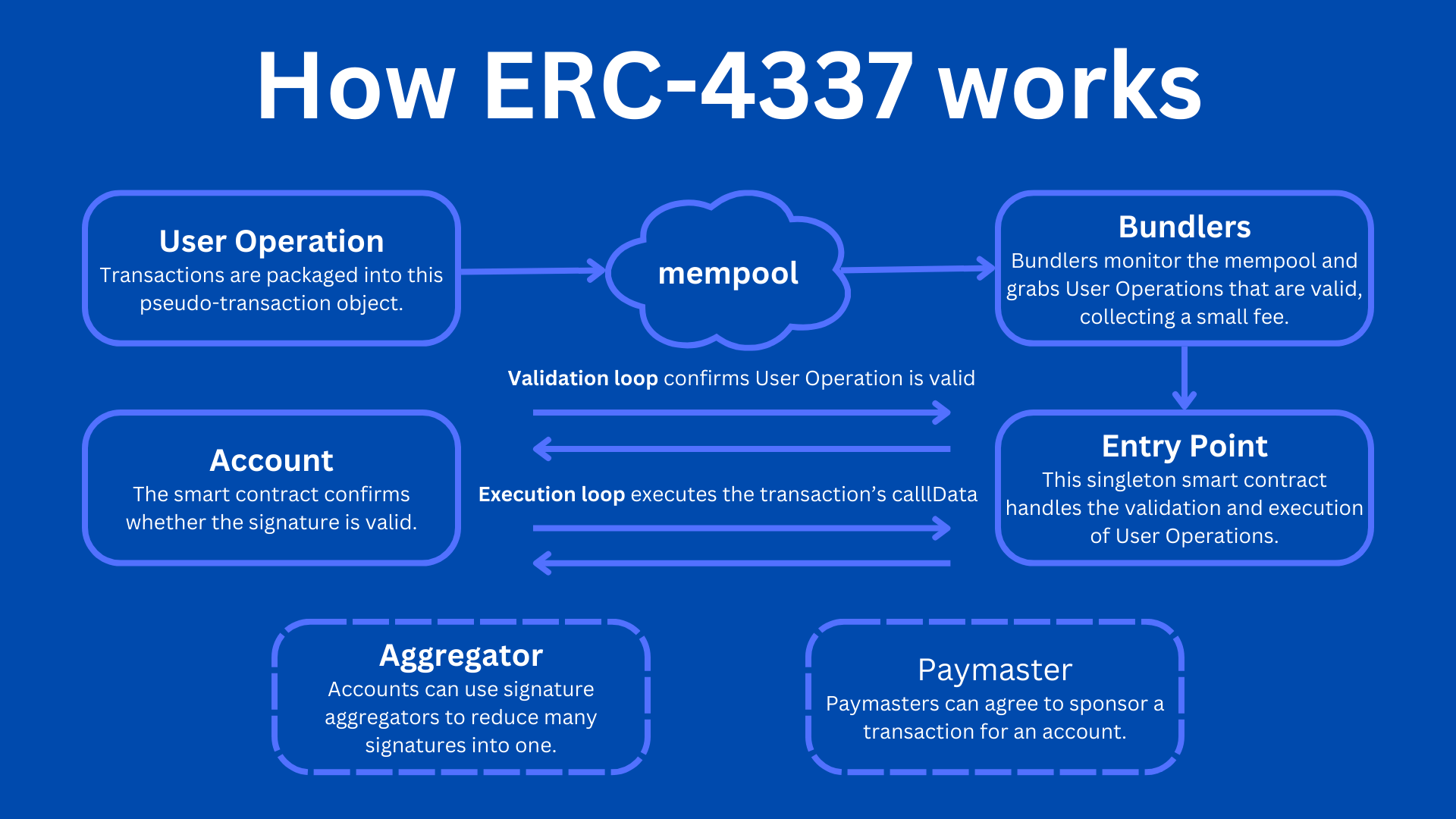
Account Abstraction consists of 5 major components:
UserOperation.
Bundler.
Entry Point.
Aggregators.
Pay Masters.
Each component plays a unique role in the implementation of Account Abstraction, ensuring a seamless and secure user experience.
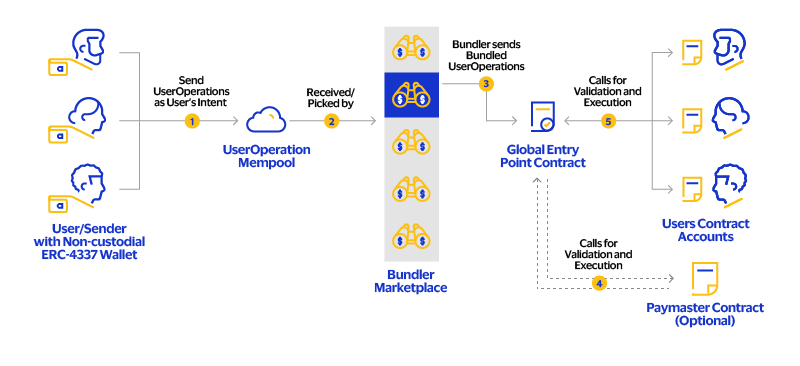
EIP-4337 shares the same goal as EIP-2938, aiming to enable account abstraction. However, it achieves this without requiring fundamental changes to the consensus layer of the Ethereum protocol.
Instead of introducing a new transaction type at the protocol layer, ERC-4337 allows accounts to bundle desired actions into a UserOperation struct. This struct serves as a container for the actions that the account wishes to execute, providing a flexible way to encapsulate transaction details.
The UserOperation objects are not immediately processed on the main Ethereum network. Instead, they are sent to a dedicated mempool specifically designed for handling these structured operations.
Bundlers, specialized entities in the network, can access the dedicated mempool to retrieve UserOperation structs. These bundlers then package multiple UserOperations into a single bundled transaction.
The bundled transaction makes a single call to a global entry point contract on the Ethereum network. This global entry point contract is responsible for executing the bundled operations in a coordinated manner.
By introducing this structure with UserOperation and bundling, ERC-4337 achieves the goal of account abstraction, allowing accounts to package and execute desired actions without requiring changes to the underlying consensus protocol. This approach offers a flexible and efficient way to handle diverse transactions within the Ethereum ecosystem.
Use-Cases and Benefits.
EIP-4337 heralds a multitude of advantages, propelling both users and protocols into a more efficient and versatile realm:
Gasless Experience Through Protocol Sponsorship: Protocols can now sponsor gas payments, providing users with a seamless and gasless transaction experience. This enhancement removes a significant barrier for users, fostering a more user-friendly environment.
ERC20 Token Gas Payments: EIP-4337 introduces the capability for gas payments to be made in ERC20 tokens, eliminating the need for users to directly hold or use native ETH. This flexibility enhances user convenience, opening the door to a broader range of transaction options.
Support for Alternative Verification Mechanisms: Beyond ECDSA, EIP-4337 supports alternative verification mechanisms, a crucial move for future-proofing Ethereum against potential threats from quantum computing. This adaptability ensures the long-term security and sustainability of the Ethereum blockchain.
Improved User Experience for Account Permissions: The proposal enhances user experience by facilitating the implementation of more granular account permissions, including role-based account access. This development empowers users with greater control over their accounts, aligning with evolving security and privacy requirements.
Elevating Multi-signature Accounts: Multisignature accounts, once confined to a secondary status, become first-class citizens under ERC-4337. This change is expected to encourage wider adoption of multi-signature accounts, contributing to enhanced security and decentralized decision-making.
EIP-4337 stands as a testament to Ethereum's commitment to innovation, adaptability, and user-centric design. As the Ethereum ecosystem evolves, this proposal positions itself as a key enabler of a more inclusive and feature-rich blockchain experience.
Conclusion
The high-level account abstraction implementation in EIP-4337 provides various benefits to users and protocols. Protocols can improve their users' experiences by sponsoring transaction fees, and consumers can even use ERC-4337 to pay directly in ERC-20 tokens. ERC-4337 is an important first step towards building quantum computer-resistant transactions on Ethereum. Finally, Ethereum's account abstraction is a major changer in blockchain technology. It improves security, customization, and adaptability while simplifying interactions with the Ethereum network. We should expect a more user-friendly and feature-rich blockchain experience as developers explore its possibilities, bringing us closer to universal blockchain adoption.
References
Socials
If you enjoyed this article ❤️, recommend sharing this article with your peers and don't forget to check my social-media handles.
Subscribe to my newsletter
Read articles from Mrinmoy Porel directly inside your inbox. Subscribe to the newsletter, and don't miss out.
Written by

Mrinmoy Porel
Mrinmoy Porel
Hi I'm Mrinmoy👋. A software developer for the decentralized web. I contribute to open source, write blockchain tutorials, build projects publicly related to decentralization that the world needs to know about.